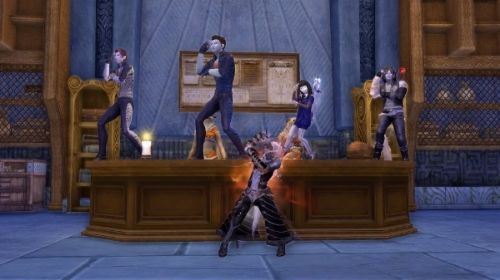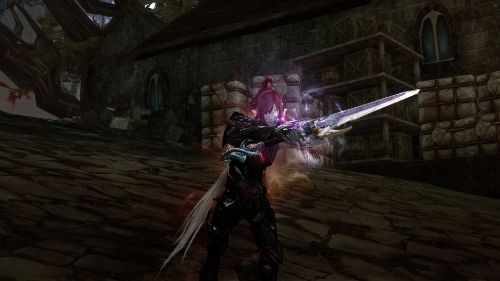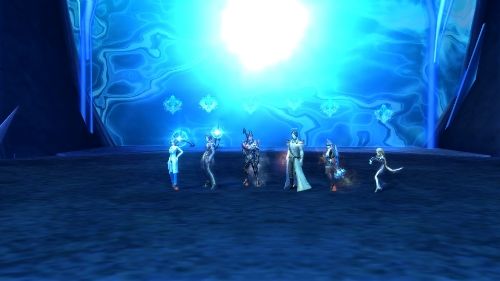Features to be added:
Named Mobs: Locations/Maps
Gearing Process and Options: What armor to get.
What Not to do in the Eye: Bugs/Exploits to AVOID
PvP Friendship 101 - A good way to bond with your fellow players. Don't drive them away, get to know them.
Tiamat Stronghold Guide (Almost done! Just adding pictures!)
Dragon Lord Refuge Guide (So close, yet so far)
Leave suggestions in the comments section if you have any requests!
Staying Relevant in the post 3.0 World: A General Guide
Well hello there! Welcome to the last Aion general guide you'll ever need. This guide will encompass all of the 3.0-3.1 content with additional 3.5 info being added as it is made available. So, as this is a fairly large project I won't be able to have it all done at once! Be ready to come back and check as updates are made available, I'll bold them at the top of the guide for easy notification. If you have anything that you feel this guide needs to focus more on be sure to shoot me an e-mail at teaminfestation@hotmail.com! Well, here we go!
Gear in 3.0-3.5:
Kahrun Gear:
This was one of the larger additions to 3.0 as it provided people a fairly easy and progressive way to get top-tier endgame gear with both weapons and armor being available. For any new 60's this is definitely a good place to start getting your PvE Armor/Accessories in order before attempting any of the more difficult instances 3.0 offers.
What's the best way to get Kahrun symbols?
There are numerous ways to acquire these symbols so don't be daunted by the hefty price tag on some of the eternal gear. The easiest way to consistently get Kahrun symbols is to do the daily quests offered in both Tiamaranta and Sarpan. There will be two regular quests and one [Group] quest for each map. In addition to these daily quests there is also a set of weekly quests that reset every Wednesday after maintenance. These provide tons of symbols and it is fairly easy to find a group for the two [Alliance] quests as most players run them at least once a week. If you're on Tiamat and would like to do these feel free to whisper me on Fest. Since the 3.5 update two of the daily quests in each zone have been switched to Weekly quests and have had their rewards upgraded a bit. This saves on time and you'll total roughly the same amount of symbols per week!
I don't like doing daily quests, is there another option?
Yes! There are other options for getting Kahrun symbols. Since 3.1 came out there have been quests that are automatically acquired in every 3.0 instance that reward you with a Kahrun bundle when you kill the final boss of the instance. So, by running 3.0 instances you not only open yourself up to receive nice gear from the instances themselves but they also contribute to your Kahrun symbols!
Fest I don't have time for all this crap! Give me Kahrun symbols!
For the extremely time restricted player you aren't out of luck! In the near future you'll still be able to buy the tradeable Kahrun boxes that people are selling on the broker. As of tomorrow this promotion on the Black Cloud Marketplace ends but many players still have the conversion items and will be posting them up even after the promotion ends. If you find yourself short on time but have the extra kinah to throw around then look to the broker for some extra symbols!
What mobs should I be killing for my Kahrun daily quests?
-Coming Soon- (With maps!)
PvP Gear:
As Aion continues to develop we will continue to see more tiers of end game PvP gear pop up. Currently there are several eternal sets of PvP gear that may seem quite pricey but are often worth the work to get them. Thankfully 3.5 has brought us multiple ways to pursue this top-tier PvP gear with easier access to both AP and Mithril Medals.
(More to come here)
AP In 3.5:
If you like PvP then chances are good that you'll be needing a good way to gain AP as fast as you can to ensure a speedy gearing process. You may be saying silly things like: "
Fest! Gaining ap is slow and stupid! What do!?" Fear not, 3.5 has given us a way to make some juicy AP extremely fast and allowing us to utilize multiple methods to do so.
I love PvP! Can I make AP realistically through just PvP?
Yes! I have found the most profitable PvP to be Solo or Duo PvP in the eye as this also opens you up to finding keymasters and get some nice AP bumps through that. In addition to the eye there is also an increased level of PvP in
all cross-faction zones (rifts n' stuff). 3.5 has given level 60 players the ability to rift again and every zone is accessible!
I typically make my AP through PvP in Tiamaranta's Eye as it's fairly populated with officers trying to farm keys and whatnot, a veritable AP buffet for an Assassin such as myself. Don't worry though, any class can be successful in the eye, it's just a matter of knowing how to go about it.
Fest! You jerk! I keep dying in the eye, people are zerging like crazy!
This is a fairly common issue people have while playing in the Eye and it happens for a few reasons. First off, there is a PvP daily in there that requires five kills. Often if a group of players is having trouble finding people to fight they tend to congregate near the breakout of the opposing faction and then...a zerg is born. This can be extremely frustrating for people but it doesn't have to be the end of your PvP session.
Keep in mind that these zergs often form from players who aren't overly confident in their ability to be successful in small group situations. In order to discourage this kind of zerg PvP I urge people to start lashing out at some of these groups even if your numbers may not be on par with theirs. More often than not, if you can coordinate a bit with your fellow players you can drop high priority targets with good focus fire rather than just running back to the guards. Showing people that they're still vulnerable in a zerg is a good way to rattle their cage a bit and perhaps discourage them from zerging in the future. Not to be mean but, nobody likes a zergling.
So how do I deal with the zerglings?
The best part about the Eye is that you can quickly navigate it through the use of windstreams. One of these windstreams can be entered right from your breakout and may serve as an option to bypass those pesky breakout zergs. Now, this doesn't always solve the problem but it gives you options, and options are awesome.
To add to that thought I'd also like to urge caution at
all times while PvPing in the Eye. It's a harsh zone that, at times, will be very unforgiving to players like myself who tunnel vision their targets. To ensure a positive experience go into the Eye with the understanding that, due to the presence of these windstreams, things change very quickly and a 1v1 you were having could turn into a 20v1 without much notice. To deal with this you have to be ready to drop your fight and book it out of there if things look like they're taking a turn for the worse. Windstreams also serve as a good countermeasure to a bad situation as they're quick exits with safe destinations.
Okay, that's cool and all but what if I don't want to do straight PvP for my AP?
Don't worry, you're in good company as the vast majority of the PvP playerbase also employs alternate methods to gain AP and gain it fast. One of these methods is farming keys in the Eye. Now, it's been a while since 3.0 came out so this isn't exactly new information but hey, I'm sure plenty of people aren't fully aware of how to farm keymasters with any consistency.
Your best bet for key farming is to farm the heroic grade keys from a mob called Keymaster Zumita. There are a total of six rooms that Zumita will spawn in, they are the the small rooms in the outer ring of the eye that have mobs forming an "X" shape with a dragon sitting in the middle. These keymasters will often spawn in basic hide so make sure you're popping an eye or running into the rooms to check if anything aggros you that isn't immediately visible.

Once you find a Keymaster Zumita and kill it you are guaranteed a blue chest key. Now for the important part; you've got a key and are on your way to finding a nice box to open but that's just a little AP and you need a lot so how can you get more? Farm it. Once you kill Zumita in a room it will have a respawn time of one hour. Once this hour is up there is a 20 minute window for the mob to spawn. It is important to make note of the times you kill these mobs so you can make your way back to the room an hour after you kill it. This is a great way to make a lot of AP fairly quickly even if you only manage to get the timer on one room, so get out there!
Fest I can't seem to get lucky with Keymasters are there any other ways to make AP?
Yes! As I mentioned earlier, 3.5 has added content that allows level 60 players to rift into any zone. Why is this useful? Well, as it turns out there are new guards that have been added to provide some extra protection for low level players but they also provide a fantastic source of AP relics and mithril medals! These mobs will spawn in Morheim/Eltnen/Beluslan/Heiron/Gelkmaros/Inggison and come in groups of six.
-edit- As of 3.7 this method has decreased in efficiency since they changed the timers on some rifts (Ing/Gelk) and nerfed the guard's drop rates. A new Gelk/Ing PvP Daily was added so be sure to swing by those maps and you should automatically pick up the daily quest!
Wow, that sounds awesome, how do I find them?
This is the tricky part. These new guards will only spawn near the exits of rifts and there will typically be two sets of six guards per rift. Each guard has a chance to drop an AP potion, Mithril medal, or a Major Ancient Crown, oh yes, these guards drop the good stuff. The guards will spawn between 15-30 minutes (based on my personal observations) after the rift pops up. I'll hold off on posting the exact locations of all guards for now but I may post them in the future should the desire be high enough. Just remember that they are generally on roads and at decent "choke" points. ;)
This may sound a little too good to be true, and it is, these guards may be elites but they aren't training dummies, these guys hit back...hard. There are three types of mobs per group, they are as follows: Sentinels (Easiest), Templars (Medium), and Sorcerers (Holypoop Difficulty). As you work your way down the line you'll find that the sentinels will get stunned and slowed just like most elites as they don't have much resistance to these things (I can solo two on my assassin). Following the sentinels you'll move onto the Templars which don't really hit terribly hard but are quite resilient and resist most stuns and crowd control skills. Finally, the last things you'll contend with are the sorcerers...and oh man these guys are nasty. Unless you are running fairly high MR these may give you some trouble. They resist essentially all forms of crowd control and stuns/slows. In addition to this they also have a buttload of HP and will do things like shooting star storm which hit for like 7-8k damage. You will either need two heavy DPS classes to drop one of these before they kill you or have a dedicated healer.
These mobs all have a nice chance to drop major crowns and are a fantastic resource for fast AP gain. There are a few more things to keep in mind with this method of AP gain concerning how you pull them and minding your surroundings. Any set of guards that spawns will often be accompanied by a large cannon that players from the opposing faction may enter and do away with any pesky rifters. These cannons have set damage and can turn even a harmless pinkie into a nightmare for a few 60s. These cannons give the person inside them 200,000 HP and access to an area bombardment skill and a direct target attack skill.
If you see someone get in a cannon near you, run. If you force a player out of a cannon it will immediately disappear.
In regards to pulling these guards you'll often start by pulling all six of them at once, a potentially deadly task. To do this safely you'll need to be ready to pop defensive cooldowns. On my chanter I typically pull them all with protective ward up and hit my instant heal as soon as the initial skills land and then proceed to kite five of the mobs off while my friend(s) pull the one or two we're going to be killing. The templars and sentinels will open with force cleave (it stuns) and the sorcerers open with tranquilizing cloud (sleep storm). This can be a nasty combo as a sleep may land on you after the cleaves and leave you very vulnerable to further attack.
This all sounds awesome but can I solo these?
Soloing these guards would be fairly difficult for most classes and I could maybe see Chanters and Clerics being able to do everything save the sorcerers (unless they're MR spec). But there is one way for melee classes to farm these themselves it's just a bit less profitable. Last night on my assassin I rifted over to Inggison and killed all the sentinels at every guard spawn. This was only about six mobs in total but I scored crowns off of every single one of them and it wasn't terribly difficult to do since the sentinels have low HP and are vulnerable to blinds/stuns.
I would suggest finding a friend or two and working out an AP feed schedule maybe rotating every rift or every day. Depending on your luck you can clear several hundred thousand AP in a day if you do this right, a boon for any player seeking to get level 60 AP gear fast.
Well, this is a good start I suppose. Good enough to post for now, at least. If anyone has
any feedback or suggestions for things to prioritize then please, please,
PLEASE...leave a comment or send me an e-mail at teaminfestation@hotmail.com. Cheers, good luck gearing up!
-Fest (60 Assassin - Tiamat)



















.jpg)






